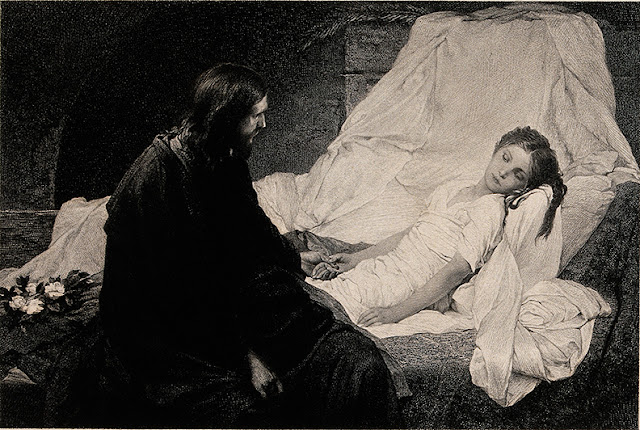 |
| Resurrection of Jairus's daughter. Etching by E.F. Mohn after G.C. von Max. |
The number of witnesses that Jewish law considered to be necessary for legal purposes was three. Jesus always used Peter, James and John ... those closest to him.
Jesus did not want more than these three Apostles to be present: three was the number of witnesses laid down by the Law (Deut 19:15). "For Jesus, being humble, never acted in an ostentatious way" (Theophilactus, Enarratio in Evangelium Marci, in loc.). Besides these were the three disciples closest to Jesus: later, only they will be with him at the Transfiguration (cf. 9:2) and at his agony in the Garden of Gethsemane (cf. 14:33).
The scene of unrestrained grief that would have greeted Jesus and his disciples as they entered really would have been an uproar. Here are a few of the details about mourning customs at the time.
Jewish mourning customs were vivid and detailed, and practically all of them were designed to stress the desolation and the final separation of death. The triumphant victorious hope of the Christian faith was totally absent.
Immediately death had taken place a loud wailing was set up so that all might know death had struck. The wailing was repeated at the grave side. The mourners hung over the dead body, begging for a response from the silent lips. They beat their breasts; they tore their hair; and they rent their garments...
Flute players were essential. Throughout most of the ancient world, in Rome, in Greece, in Phoenicia, in Assyria and in Palestine, the wailing of the flute was inseparably connected with death and tragedy....
When death came, a mourner was forbidden to work, to annoint himself or to wear shoes. Even the poorest man must cease from work for three days. He must not travel with goods; and the prohibition of work extended even to his servants ... It was the custom not to eat at a table, but to eat sitting on the floor, using a chair as a table. It was the custom, which still survives, to eat eggs dipped in ashes and salt.
There was one curious custom. All water from the house, and from the three houses on each side, was emptied out, because it was said that the Angel of Death procured death with a sword dipped in water taken from close at hand. There was one peculiarly pathetic custom. In the case of a young life cut off too soon, if the young person had never been married, a form of marriage service was part of the burial rites. For the time of mourning the mourner was exempt from the keeping of the law, because he was supposed to be beside himself, mad with grief.
The Gospel of Mark(The Daily Bible Series, rev. ed.)
=====
Thanks for that, Julie! So very interesting.
ReplyDeleteCathy Barber
Chicago
What do they mean by "table"/"chair" - isn't the custom to recline on cushions and eat at a low table or on a blanket?
ReplyDeleteYes except these are "details about mourning customs at the time." So this is atypical for that very reason.
DeleteYour question prompted me to wonder what sorts of furniture would have been common in the household at the time. I found this fascinating piece at the Jewish Encyclopedia which talks about tables and chairs, among other things, and what they would have been like. :-)
Delete